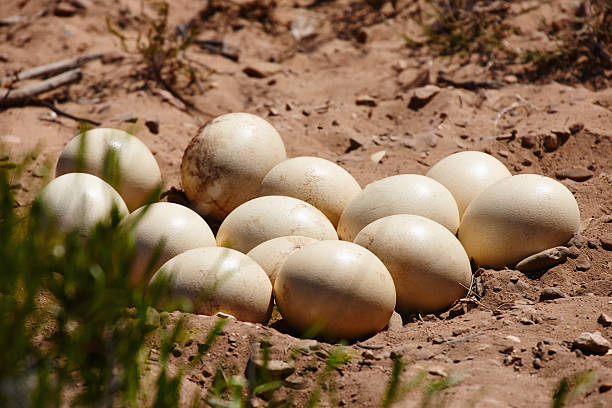How Often Do Ostriches Lay Eggs? How Big Are Ostrich Eggs?
The biggest bird in the world is the ostrich. So it comes as no surprise that they lay the largest eggs. Ostriches are now widespread throughout the world and are native to Africa. They are part of a class of birds known as ratites or land-based birds. This group also includes birds like the rhea, emu, and kiwi, to name a few, in addition to the ostrich.
An ostrich produces 12 to 18 eggs per year in its natural environment. Females can lay between 10 and 20 eggs in their first year of rearing and between 40 and 130 eggs every year after that. Perfect quantity to prepare enough omelets to feed an army!
To learn more about ostriches, including how frequently they lay eggs and other fascinating information, keep reading.
Table of Contents
How Often Do Ostriches Lay Eggs?
Ostriches typically lay 40 to 60 eggs annually between April and August, though some have been known to reach 130. Ostrich females begin laying eggs between the ages of 2-3 and reach their peak egg production between the ages of 7 and 11.
How Big Are Ostrich Eggs?
Ostriches are members of the ratites order of birds, which also includes kiwi, rhea, and emus. The largest eggs of all are laid by ostriches, but due to their size, the eggs are relatively smaller.
Ostrich eggs measure roughly 15 cm (6 inches) long by 13 cm (5″). The egg is 20 times heavier than a chicken egg and weighs about 3 pounds. 2 pounds of protein are contained in each of their eggs.
An ostrich egg costs the same as two dozen chicken eggs and weighs the same as one live chick.
Do Ostriches Lay the Same Number of Eggs Regardless of Their Habitat?
No, that’s the unequivocal response. Let’s start by stating that ostrich farming in South Africa is the best in the world. In fact, this nation’s nearly a thousand farms actively raise about a million ostriches. However, the United States and Canada, as well as Brazil and Chile, all have significant numbers of producers who raise ostriches in captivity. Additionally, Asia and Europe both have breeding farms.
But why is South Africa a world leader in ostrich farming? primarily because of the ideal climate there. Ostriches raised in this nation actually lay up to 35% more eggs than those raised in Europe because of the hot, dry climate of the African lands.

Can You Eat Ostrich Eggs?
Ostrich eggs are edible, so you can eat them. Approximately 2,000 calories are in one egg. The magnesium and iron content is higher compared to chicken eggs, but the vitamin E and A content are lower.
An ostrich egg is not very practical to cook or eat, though. It would take almost 90 minutes to hard boil an ostrich egg, according to the American Ostrich Association.
It’s also not advised to fry the egg. It’s unlikely that the majority of people would have a skillet or other cooking tool big enough to handle the size of an egg. In addition, the shell is so tough that breaking it requires a hand saw or hammer!
Given all that about the eggs, it’s a fair question to ask “can you eat ostrich?” The answer is yes, and a lot of people actually support it.
One of the healthiest types of red meat is ostrich meat. For those with sensitive stomachs, it is a good option because it is easily digestible. It has a ton of flavor and is extremely lean. It can replace beef in recipes 1:1 and has the flavor of a premium cut of beef.
Also sustainable and humane, ostrich. On farms with wide open fields, ostriches typically reside. They do not receive antibiotics, hormones, or steroids. In comparison to raising beef, raising ostriches has a lower environmental impact. Compared to beef cattle, they require less water and less land. They emit almost no methane and less greenhouse gas.
What to Do With Ostrich Eggs in the Modern Day?
In North African homes even today, decorative ostrich eggshells are still in use. They could be gold-plated and hung on a chandelier or used to decorate the straw roofs of huts.
Additionally, jewelry and small ornaments are made from shells. To make necklaces, pendants, belts, and anklets, small discs and shapes are cut from the shell.
In an effort to create brand-new antibiotics for bacteria and viruses, scientists are also researching ostrich eggs.
The Dean of Veterinary Science at Kyoto Prefecture University in Japan is Yasuhiro Tsukamoto. Over a period of years, he researched ostrich eggs. He is exploring the possibility of tailoring the antibodies from an unfertilized egg to create drugs for people. His research has not been published or subjected to peer review and is still in the pre-clinical stage. However, some of his research offers hope for eradicating the dengue virus.
Conclusion
Ostriches are enormous, fascinating birds. Although the number of eggs laid by wild versus captive-bred ostriches differs significantly, they also produce eggs of impressive size. Ostriches raised in captivity can lay up to 130 eggs annually, compared to the average of 40 to 60 laid by wild ostriches, which lay an average of 12 to 18 eggs annually. Of course, the level of care, surroundings, and climate have a significant impact on how much these enormous birds can lay.